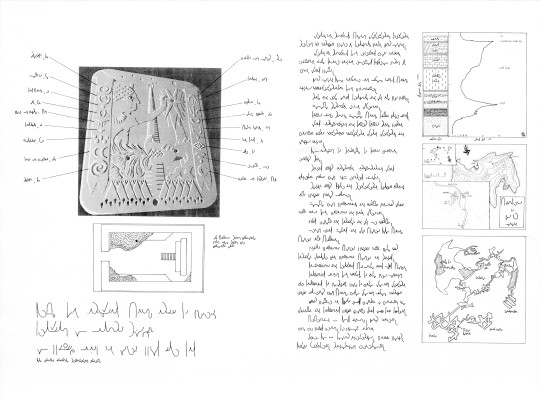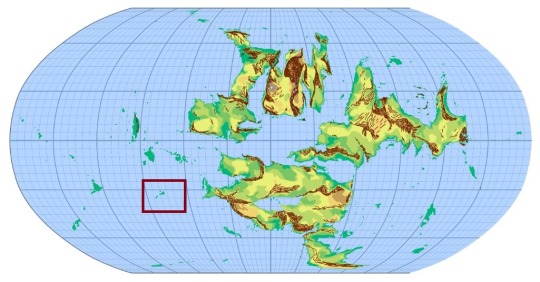#I haven't posted in a bit so I forgor my tagging systems 😔
Text
Seven-Fold Sea Periphery: Scale Islands Archaeological Site Findings


On top is the full extent of the document, closer copies and more detailed explanations to follow
Below is a world map, outlining the location of the Scale Islands with a dark red box
Located on the southeastern edge of the Seven-Fold Sea phenomena, the Scale Islands are an archipelago of space-originating islands formed of fragments broken off of the First Bright Moon, having gradually accumulated thick limestone beds in the lowlands during the last period of major sea rise.

A map of the Scale Islands
The lunar rock found in the islands has long been prized as a building material, with quarrying evident from the time of the first Hurricane-Engine City Ships, with temples constructed from the material present from the Salt region to the Crust region.


On the left, the rock type by depth of the archaeological dig, with the corresponding energy levels recorded by depth to their right.
On the right, the Island of Baltora, with an inset map showing the location of the archaeological dig.
The islands have been of note in recent years due to the discovery of an array of large-scale cave systems deep below sea level of a similar type as the long known lower reaches of the Bunker region. Evidence of human cohabitation dating back to the early Xerranian period is present in some of these caves, having remained untouched since then as opposed to the still currently inhabited caves in the Bunker region.
The particular site was discovered through drilling undertaken in a quarry in the east of the Island of Baltora.

The known extent of Baltora's Lunar cave system, with the entrance present in a small cave to the left of the largest chamber indicated by a +▵
The site of the discovered mural is indicated by a small star in the bottom roughly hexagonal segment
Preliminary examination of the inhabited sections of the cave have proven fruitful, with recent advancements in the Neon regions image capture technology having cut down energy costs to the point images can be captured without large, heavy infrastructure, and without the resulting energy output scouring all spirit/energy traces which can be useful for anthropological studies.

A sketch of the room containing the mural, with the location the image was taken indicated by a small star
The mural (10.8m Tall by 8m Wide) appears to show a draconic being and a humanoid towering above mountains and forests, with a stairway leading up to a large circular structure (presumably the moon) visually continuing the stairway up to the mural. Holes in the base of the mural appear to have been used to hold scrolls, while indents in the figures and patterns likely were meant for gems.

The photo of the mural, with annotation attempting to translate the symbols on the engraved scrolls to the left and right
A translation of the main body text from the Linear script into English has been provided below, any more specific translations will be provided by request.
Image taken during the year 927 expedition into the newly discovered macro-scale cave system located in the Scale Islands using a low energy grayscale LightCord camera isolated within a hooded pouch laced with silver to prevent energy contamination of the site.
The Scale Islands are known to originate from chunks of the first moon which fell from orbit several million years ago in planetary time, experiencing a crash consistent with stellar bodies, exhibiting little gravitational attraction and lacking mechanical failure upon impact.
The mural was found in the southern edge of the cave system, in an area identified as having human habitation. The chamber itself is notably formed of fossil space, an unusual anomaly considering the freestanding voids of the other constructed caverns in the area.
Wax placed along the left and right sides of the chamber formed out of an unknown plant based material, this wax contains Energy traces which date the last major residence of the site roughly 45000 years ago in local time. The date cannot be identified more precisely, as the material's energy decay rate is unknown.
The mural's ordered spirit is well formed, having very little intention pollution which occurs in public facing facilities. The intent of the mural's creator was preserved through the period the site was in use, suffering less than 10% pollution.
The chamber has partially collapsed near the opening on both sides, with dust stranding in the air above the rubble piles typical of a natural collapse rebound of a pocket of fossil space. Residual corrosive residue on the rock near the entrance clued in researchers to the rooms existence, appearing to have been the result of the hinges and locks of a doorway.
Small degrees of mechanical erosion of the rock in its early period is evident in the intent pollution experienced by the murals spirit, likely from cleaning the soot created by the candles off of the surface.
Chemical damage to the mural was caused by seawater intrusion into the chamber through the caves connections with the overlying limestone rock, the resulting erosion occurred in a low energy environment. This damage was not repaired until the high energy seas of the Abyss era, magnifying the spirits repair of the mural, resulting in the current murals rounded features.
Translations completed in concert with the people's of the island chain, along with the older translation work completed by the L'emmerak expedition of early y200, as the symbol base discovered in the Bunker region Lunar Caves dates back to the same region.
Direct influence by Miss Ziava-Ossan is unlikely, but cannot be ruled out during translation, none of their signature Pitch Black energy was captured by the candle-wax within the room at the time the image was taken.
Contributing Authors: Nessen Ralynoh, Ialm Chiroha, Parruh and Lakkan Collu, Geissec Harzui.
Citations: T. Iyottumaya, K. Keke'ralm, G. Vadizoa, M. Porovska, L'emmerak
#conlang#map#fantasy maps#anthropology#fantasy anthropology#fantasy map#I haven't posted in a bit so I forgor my tagging systems 😔#also a fun detail - you can probably translate the symbols on the mural from another of the conlang's I've posted about on this blog#sadly this project is slightly unfinished since I did it for an art class#so I had a specific time limit ¯\_(ツ)_/¯
24 notes
·
View notes